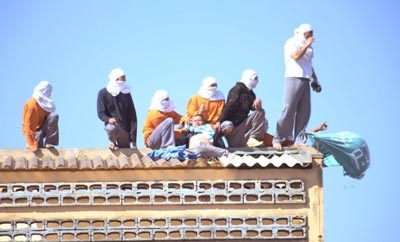A deadly riot in southern Brazil illustrates how inhumane prison conditions and powerful prison gangs create an explosive situation, which authorities are sometimes tempted to resolve by negotiating with gangs like the First Capital Command (PCC).
A recent prison riot in Brazil’s Parana state left five prisoners dead — two by beheading — 25 wounded and Cascavel prison in shambles. (Of seven inmates initially reported missing, six turned out to have been long since transferred to other prisons.) After a tense 45-hour standoff, officials finally met inmates’ demands to address overcrowding by promising to transfer some 800 of the prison’s 1,040 inmates to other facilities. Just to be certain, prisoners continued to hold two guards hostage (of only nine on duty at the time of the riot) until the transfers were completed.
The incident follows numerous recent cases of prison-related violence throughout Brazil, all of which bore the fingerprints of the country’s most powerful criminal organization, the First Capital Command (PCC). While Cascavel prison appears not to have been entirely dominated by the PCC, as are the vast majority of Sao Paulo prisons, the organization clearly had a strong presence: its name was found painted on the prison walls and on banners hung by rioting inmates during the standoff. Indeed, the brutal murders of five prisoners are thought to have been score-settling, possibly ordered by local PCC leaders. Equally telling, and particularly worrisome, was the use of a classic PCC tactic, simultaneous attacks beyond the prison walls: while the riot flared at the prison itself, affiliates burned a bus and a car belonging to the city government right in front of city hall, and spray-painted “PCC” nearby for good measure.
SEE ALSO: PCC Profile
Instances of prisoner abuse and neglect have driven similar episodes of violence in far-flung corners of Brazil, and in each case, PCC franchises or affiliates have been involved. Authorities, journalists and scholars are beginning to connect the dots: execrable prison conditions and prison gangs are an explosive mixture.
Why is that? Criminal networks like the PCC are far more sophisticated than the name “prison gang” suggests. They are not so much a rapacious band of thugs as a kind of inmate shadow government, enforcing codes of conduct that bring order to prison life and make most inmates better off. The allegiance this inspires then helps gang leaders orchestrate collective resistance to guard abuse and official neglect.
The threat to state authority posed by prison gangs lies partly in their ability to project power beyond the prison walls, controlling street-level violence in ways that force officials’ hands. The PCC in particular has perfected the art of synchronized attacks, like the citywide shutdown of Sao Paulo in 2006, of which the bus-burning in Cascavel was a small but potent reminder. These tactics amplify prisoners’ leverage over state officials. As a Parana state official put it, “our best option was to negotiate.”
Inhumane prison conditions, however, also play a key role in empowering prison gangs. Gross neglect and abuse foments mistrust, desperation, and rage among the larger inmate population, which sophisticated prison gangs can channel into organized revolt. More importantly, mistreatment of prisoners hands prison gangs perfectly legitimate motives for such revolt, if not for their violent means. This allows politically savvy groups like the PCC to present themselves — cynically but not totally inaccurately — as human rights defenders, and can potentially undermine the state’s own legitimacy.
States generally regard negotiation with criminal groups as taboo — far more so than negotiation with insurgents and other overtly political groups. Yet as the line blurs between criminal coercion and legitimate protest, negotiation comes to seem more acceptable. Add to this prison gangs’ proven ability to reduce street-level violence and it is understandable how officials in Brazil, as well as El Salvador, have sought to craft deals with imprisoned gang leaders.
SEE ALSO: El Salvador’s Gang Truce: Positives and Negatives
These deals have saved lives and pacified urban war zones, but they also strengthen prison gangs and set precedents that could encourage similar groups — there is a taboo for a reason, after all. In the short run, the official in Parana is probably right: negotiation is the best option. Over time, though, without a fundamental shift away from the mass incarceration policies that fuel prison gangs’ growth and propagation, states may find themselves ceding ever more ground to increasingly powerful — and increasingly political — prison-based criminal networks.
*Benjamin Lessing is Assistant Professor of Political Science at the University of Chicago.

